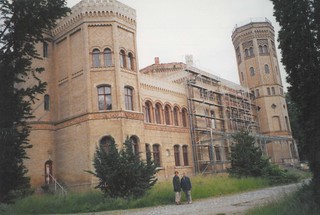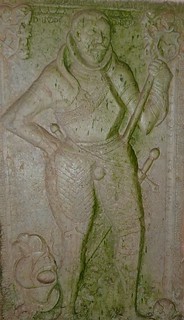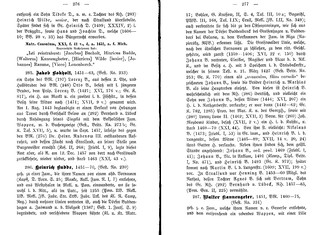Introduction
During the month of June in 2002 Louise and I traveled through northern Germany: Rügen and Pommern and from there to Estonia and Latvia following the trail of the Budde clan that lived in these areas from 1100 till 1700.
Back in early 2001, I had made contact with Tanja-Isabel Budde in Greifswald. She studies in Greifswald but her family comes from Westphalia, so there is no connection between her and the Buddes in Pommern. She had already provided me with a very valuable ‘starting kit’ about the region and an excellent road map that had all the places on it that we wanted to visit. Once in Pommern we of course also met up with her and she offered us to be our guide and with her we traveled though Ost-Vorpommern.
From here we followed the Budde trail in Estonia, in particular Saareema and in Latvia.
The most famous Budde family in Pommern (and also Oesel/Saaremaa (Estonia), Denmark and Norway)
All Buddes investigating the family history will come across Matthias Budde, the most famous ‘cousin’ of the family.
This family resided at the mansion in Nessow or Neetzow and had other manors in Gramzow and Rinow. They belonged to the nobility of Mecklenburg and Pommern. This family later on went to Denmark, Norway and Osel (Oesel) in what is now Estonia.
Around 1500 Andreas (Drewes) Budde lived, with his wife Margaretha Winterfeld (?), in Neetzow (a small village between Greifswald and Anklam). We visited the sizable castle of Neetzow, most probable the place were Andreas lived. The current castle however dates from the 19th century and was at time under restoration.
In 1517 Drewes received from Count Bogislaw X of Pommern, the rights to two farmsteads as well as a farmstead with a cottage in the village of Nessow. This was changed to a feudal tenure the following year. These rights also applied to his sons Henning and Matthias. Henning Budde was married to Dorothea Ruske (Rausche). They had at least two children (sons) Matthias and Godslev. In June 1566 Matthias was enrolled at the University of Greifswald. Both brothers moved to Denmark in around 1570 and they, as well as their descendants, formed an important part of the Danish nobility during the next 100 years (At that time Pommern was part of the Danish empire).
In 1575 Matthias became secretary in the German Chancellery. In 1577 he was appointed Hofjunker and 1580 invested with the provost Thyholm. He was a Danish envoy in England and Poland . From 1584 to 1589 he was governor of Saaremaa, where he bought the estate Tölluste.
Matthias Budde was married with Ursula Behr a daughter of Johann Behr, the Danish governor in Kurland (Courland now Latvia) and Margaretha Grotthufi .
He died in 1591 and his grave stone with relief is situated in the Church Gramzow in Mecklenburg-Vorpommern .
Godslev died in 1622 and his son Friedrich lived on in Oesel (Saaremaa) and was married to Anna Urup. She was the sister of Karen Urup, who confusingly was married to Matthias son, also named Friedrich. This family died out with his grandson in the middle of the 17th century.
Another family member Jochum/Joachim von Budde († 1617) held the influential office of Marshal of the Duchy (Hofmarschall) of Pomerania-Wolgast. The family later settled in Hinterpommern where, through marriage, they established family ties with the influential families of the Podewils and the Blanckenburg.. At the beginning of the 17th century Christoph von Budde was Pomeranian Hofmeister, Court and District Council and Canon of Kamin and Kolberg. However at the beginning of the 18th century the Budde family in Pommern had died out.
Because of their strong relation with the Danish Court, other family members returned to Denmark and from here also settled in Norway which at time was in a personal union with Denmark.
The line which the Danish governor on Oesel Matthias Budde back, could be sustainably spread by Oesel, however, the bond to Denmark has always remained strong. Several members returned there but also by Norway.
With no family members left in Saaremaa, their estate Tölluste was sold by the family on April 8th 1685. See also Estonia.
The Danish branch of the family died out with the death of Anna Sophia Budde 1796 in Hjørring. See also Denmark.
In Norway, the family Budøe has taken the name and coats of arms of the Budde family. See also Norway.
Puzzling is a reference to a Hennig Budde from Neetzow (Reetzow) married to Katharina von Dewitz and a Margarethe Budde born in Neetzow (Netzkow) before 1567, she died after 1625 and married around 1600 with Bernhard von Zepplin.
The family still had a manor in Rinow in 1686, but disappears from the records after that. Other records indicate that they died in poverty.
Coat of arms: Divided obliquely, above: a half silver unicorn in blue, below checkers in gold and blue. (see: www.svenskadel.nu/Danheralds/index.asp)
Link to the present
In late 2002 I received an email from Rodney Stone, Williamsburg, North Carolina USA. His family comes from the Neetzow line through Vestnes, Norway as follows: Andreas, Godslev, Fredrich and Helle Budde. She married Reinhold von Howen, her child Anna Shopie von Howen married George Schultz. Their child Morton Schultz (born Vestnes?) married Iverisse von Munthe, their child Anna Catharina Schultz married Borge Eeg. Frome here the line goes: Jacob Andreas Eeg, Henrik Remmem, Hans Henriksen Soras, Ole Hansen Soras, Rasmus Olsen Soras, Alpha Soras and Rodney Stone. Rod Stone email: stone@widomaker.com
History of Pommern
The Baltic coast remained ‘pagan’ land occupied by west-Slavic tribes. From the 8th century the Vikings began their raids on Europe and the Vikings from Denmark became the controlling power on the Baltic coasts. In the 10th century several of these tribes united under the first Polish dynasty of the Piasts. Pommern was part of unification process and became part of the initial territory of (larger) Poland.
Around 1150 Poland entered into a two-century period of feudal disintegration, which resulted in painful territorial losses, mainly to the German feudal lords. The margraves of Brandenburg launched a frontal attack on Pomerania, destroying the former territorial and political, administrative and church structures and leading to the formation of the predatory New March, while in the eastern part of Pomerania a similar role began to be played by the Order of the Teutonic Knights (see below).
As a result of consistent colonisation of Western Pomerania and the Germanisation of the ducal dynasties, Brandenburg established strong influences over this region. The expansion towards linking up the Teutonic areas with those occupied by Brandenburg was halted by the great battle at Grunwald (1410) and later by the 13-year war that ended with the peace of Torun (1466), in which Kazimierz the Jagiellon regained Gdansk Pomerania and subordinated the rest of the lands taken by the Teutonic Knights as a fiefdom.
After the 30-Years-War (1648) Pommern consisted of two areas: Swedish-Pommern in the West under Swedish rule and the Eastern area under the rule of the Brandenburg Electors (Prussia).
After the defeat of Napoleon, Sweden in 1815 renounced all her claims to areas in Germany including Pommern. Pommern west of the Oder River was also called Vorpommern (Cis-Pomerania) while east of the Oder River Hinterpommern was called (Trans-Pomerania).
In 1938 areas from the former provinces of Westpreussen and Posen which were lost after WWI were added in an administrative reform. In 1945, Poland took all Pommern East of the Oder River (Hinterpommern) as well as the area around Stettin (Szczecin).
The Teutonic Knights
A regular order developed, during the third crusade, from the German Hospital Society (1190) set up by German merchants in Akko, Palestine. The members, who were nobles, became a knights’ order in 1198 to fight ‘infidels’ in northeastern Europe. In this process they acquired a large number of properties all over northern Europe. They assisted the German emperor to conquer the ‘heathens’ in Prussia. In return they were allowed to establish their own territory between Thorn and Kulm (this later became Prussia, of which Pommern formed a part). This process of ‘christening’ led to many quarrels and wars with a rapidly disintegrating Poland. In 1237 they merged with the Knights of the Swords. This also brought the Knights into Courland, expanding the German influence to the borders with Lithuania, which they never conquered. This region became known as Livonia and included what is now Estonia and Latvia. In 1308 they conquered Pommern. They lost Courland in 1558, when it became an independent duchy.
The Teutonic Knights also obtained properties in Ootmarsum, the Netherlands, where we come across another line of the Budde family in the 20th century.
Napoleon, in 1809, dissolved the Order. See also: Crusades
Another Noble Budde Family from the north – Rügen
While there are no direct links established between the above mentioned and another branch of the family, there are strong indications that they two are linked. The first recorded Budde ever is Alard Budde in 1130 in Stralsund (Strelasund) at that time Stralsund was part of the Kingdom of the Slavic tribe the Rani (Ruani, Ruaju). During the migration period they had replaced the Germanic tribe of the Rugii. Both archaeological research and the name similarities indicate that there was some sort of continuation rather than a replacement. The names Alard and Budde also have a strong Germanic link. In 1168 the Danes conquered the Rani and established the Danish Principality of Rügen (Fürstentum Rügen). It consisted also both the island of Rügen and the adjacent mainland. They occupied it from 1168 until 1325. It was governed by a local dynasty of princes of the Wizlawiden (House of Wizlaw) dynasty. For at least part of this period, Rügen was subject to the Holy Roman Empire.
This part of the Budde family appears throughout the area of the old Principality of Rügen, which also included parts that were consequently parts of Pommern and Mecklenburg (nowadays the whole region is part of the Bundesland Mecklenburg-Vorpommern).
Their are similar names of Budde sons and there are also places they share such as the small town of Neetzow and the christian name Henning, strong indications that there might be links.
Stralsund
Stralsund is a lovely Hanse city, with the merchant houses, churches, a town hall and street plans that are so typical to these cities. The interior of the church is an absolute jewel with lots of very early wall paintings in spectacular colours.
Stralsund
Stralow, the Slavic name for the city, was established on the strip of the Pommern coast, which belonged to the Kingdom of Rügen. On October 13th, 1234, Witzlaw I Prince of Rügen granted the settlement at the sound the status of a town. Trade and shipping crystallized as the most important sectors of the town’s rise, a fact which is revealed by port regulations issued already in 1278, and, in particular, by Stralsund joining the Hanseatic League at the end of the 13th century. The economic rise ran parallel to an increase in political strength in opposition to the town ruler, who first was the (Slavic) Prince of Rügen and, from 1325, the new ruler the Duke of Pomerania.
On May 24th, 1370, after a several-year lasting war with the Danes, the Treaty of Stralsund was concluded between the Hanseatic League and the Danish Kingdom in the town hall of the town at the Strelasound. From that time onwards the city grew in power and richness and this provided them with many privileges, granted to them to the various dukes and princes. This gave unprecedented freedom to its citizens, this enlightened rule also had its effect on Rügen, where most farmers were able to also buy themselves free and many wealthy farmers married into the various noble families on the island.
As mentioned the first recorded Budde ever is Alard Budde in 1130 in Stralsund. Other members of the Budde family in Stralsund are recorded in the ‘Stadtbuch’:
- Arnold Budde 1350
- Hermann Budde 1358
- Gotscalaus Budde 1415
- Heinrich (Henning) Budde 1437
Henning Sleffe ceded in 1449 some farms (or land) at Papenhagen and Müggenwalde to the Stralsunder citizen Henning Budde.
We visited the Rathaus where these documents are and made contact with the archivist, however consequent emails remained unanswered.
Principality of Rügen
Introduction
On the other side of the Sound, the narrow 2.5 km waterway lays the island of Rügen. There is a bridge and a causeway from Stralsund that leads to the island. We travelled here for a day and enjoyed the holiday atmosphere. It is one of the major holiday places for the Germans. In 1942 Hitler decided to build holiday accommodation for 20,000 people. While the project was completed before the end of the war, the kilometres-long row of ugly apartment building along the beautiful beach was never used. It is now an eerie ghost ‘town’ with partly collapsed buildings. The natural environment of the island is stunning with lakes, wetlands, beaches, a few hills and forests.
In Rügen we also come across Buddes. They appeared to have belonged to the Neetzow branch (see above). They were first mentioned in 1304 when a Hennig von Budde was mentioned as a councillor to Prince Wizlaw III of Rugen.
The family also appeared in the neighboring Mecklenburg since 1353 (at that stage part of the the Duchy of Saxon).
Rügen
After the last ice age, the Baltic Sea started to fill up with water but left the highest parts of what now is the island of Rügen dry, over the years silt filled up the areas between the peaks and large parts of the island became swamps (bodden). Germanic hunters and gatherers visited the island from 6,000 BC onwards. However, around 600/700 AD the Slavs replaced them. These people ruled independently and had their own kings. Around 1100 Danish Vikings conquered the island, after they already has conquered large parts of the neighbouring mainland. However, the Rüganen where able to maintain their independence and equally operated as ‘Vikings’ raiding the coast of Denmark.
They withstood a crusade under Bernard von Clairvaux (see also chapter: Sünte Marienrode) and battles with Danish and Swedish fleets. They were able to defend themselves against all odds until 1168, when a combined force of Danish, Saxons and Pommerns attacked the island under the fanatic leadership of Bishop Absalon. Not just to conquer them but even more importantly to convert them to Christianity! Their sacred site at Arkona, where they worshipped their god Swantewit was totally destroyed. Still the island was able to maintain, as a Slavic island, a certain rule of independence, be it now with a new religion. Despite Danish rule the colonisation that followed the christening of the island brought in Germans rather than Danes. By 1400 the Slavic language and culture was totally replaced. After the violent years during the 12th century, a peaceful time followed that in particular brought great wealth to the new city of Stralsund on the mainland of the Kingdom of Rügen. After the death of the last Slavic king in 1325, the duke of Pommern inherited Rügen.
A new master arrived after the Peace of Westphalia in 1648, when the Swedes took over, this ended in 1815, when it became part of Prussia.
Glewitz (Rügen) – Lund (Sweden)
According to research conducted by Gunnar Krogsbøll, we come across a Budde line that also starts in Rügen, in Glewitz.
In the charter of the town of Damgur/Damgard (south of Barth, Pommeren) dated 1258 there is a mentioning of Johannes Budde.
The Budde’s in Damgur
Prince Jaromar II of Rugen attacks Copenhagen in 1258, Prince Jaromar II of Rogen built a fortress at the mouth of the Recknitz River, and it later became the town of Damgur. In 1259, Prince Jaromar II sailed to Denmark and attacked Copenhagen.Prince Jaromar II of Rugen attacks Copenhagen in 1258, Prince Jaromar II of Rogen built a fortress at the mouth of the Recknitz River, and it later became the town of Damgur. In 1259, Prince Jaromar II sailed to Denmark and attacked Copenhagen.
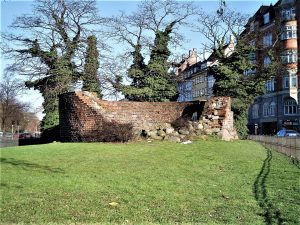 Under the heading “Kend Kobenhavn” I have found on the Net the following report: Jarmers Plads “The square takes its name from Prince Jaromar of Rügen, who attacked Copenhagen in April 1259 and trudged through Vestervold (city wall). At that time there was a dispute between the King and the Bishop of Roskilde, who had power over Copenhagen. The bishop, Jacob Erlandsen, stood firm on the Pope’s rights and influence on the royal power, and this did not suit King Christopher on 1 January. He put Bishop Erlandsen in prison and humiliated him by ‘putting a fool’s hat on him from which hanged rave tails. At the same time, the Wends operated raids along the Danish coasts, and as they were faithful to the Pope, they entered the conflict. Prince Jaromar attacked Copenhagen and demolished most of the city. He also burned the castle. However, peace was made on condition that the bishop be set free.” In the town of Damgur’s Privileges document, a Johannes Budde is mentioned, and in a German website it is claimed that he was “milis”, i.e. soldier (knights?). Another website states that Johannes Budde had 2 sons, Ernst Budde and Reinfried Budde and that in 1283 they were both gunners. As a soldier, Johannes Budde may have been at the attack on Copenhagen, while his sons may have been too young to go to war in 1259. Gunnar Krogsboll, September 2022 |
In the years 1295-1302 Domini (Master) Ernesti Budde is mentioned several times. In 1295 he also appeared under Werlischen chivalry. The County of Werle was part of Mecklenburg.
Most likley this is the same person as mentioned in “The Letters of the Kingdom of Denmark” from 1301, here Gunnar found a letter from Prince Vizlav II, in which he also mentioned his knight ( Vasal ) Ernst Budde. When Ernst Budde is a knight in 1301, he must have been born somewhere between 1250 and 1275.
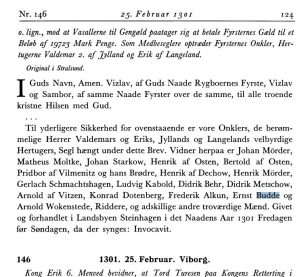
It could be that this is the same Ernst Budde who went back to his native town of Glewitz in 1362 and died there on the 11th. August.
In 1349 a Johannes Budde (son, brother of the knight) is named as the owner of the Glewitzer farmstead; this was sold in that same year to the Gristow family who sold it to city of Greifswald. The ferry and ferry house had previously also formed part of the property, but they were split off in 1337 and in 1401 sold to the city of Stralsund. Glewitzer (Slavic: ‘Chlevec’ which means stable) is situated in the south, close to the Stelasund. Seven hundred years later, the ferry still exists and while the buildings might be different there is still only one farmhouse here.
The next Ernst Budde who was born in 1345.
He marries Ǽtǽfella Jensdatter Bukhorn, who was a daughter of the nobleman, the squire Jens Johan Bukhorn (whose family has been traced back to around 1300 in Lund).
The Budde family was very wealthy, they probably made their fortunes as merchants. They might have participated as a Hansa-merchant in the herring trade and was part of the great herring-fishing-fleet in Skåne during the 13th century.
He was a Councilman in Lund, and according to an old town-regulation, only merchants were allowed to be elected as Councilman in Lund.
Herring market in Stralsund
| Stralsund was for many years part of the Hanseatic League. In Denmark, it is known for the peace treaty of Stralsund on 24 May 1370, where Valdemar IV Atterdag mortgaged Skane to the Hanseatic League and gave it the right to control the herring markets in Skane. This could be a good reason why Ernest bexame involved in the herring trade.
Valdemar IV Atterdag, or Waldemar was King of Denmark from 1340 to 1375. He is mostly known for his reunion of Denmark after the bankruptcy and mortgaging of the country to finance wars under previous rulers. |
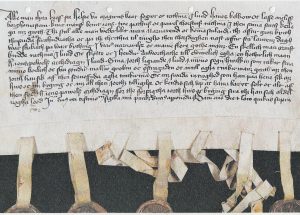
This is a parchment letter about Ernst Budde. A transfer to the church of some of his properties in Lund.
There is some evidence that there was a very friendly connection between the Budde family and the Cathedral in Lund. When Archbishop Jacob of Lund wrote his will shortly after 1410, he thanked Ernst Budde with a Hungarian guilder, and in 1423 Ernst Budde handed over part of his properties in Lund to the archdeacon of the cathedral in Lund, Jens Pavelsen.
Ernst became Prior of Saint Peters Monastery in Lund, mostly inhabited by unmarried noble-ladies.
It looks like Ernst’s son Lars took over the business. He was married to Kirstine. They most likely had three children: Ostric, Hans and Else.
After Lars’ death she testifies to an association at the cathedral. Ostrid was a priest at the cathedral. As a priest in a Catholic church, he was not married, and it is therefore likely that it is he who arranged Kirstin’s will, and secured her a residence in the ‘merchants garden’, as soon as his sister Else moves. It is probably her other son, Hans who continued the merchant business from his father. (Gunnar Krogsbøll).
Than there is an other Ernst Budde who around 1330 studies in Bologna, under the Latinised name Ernestus, he is mentioned as a procurator from Saxony.
Ernestus Budde
| Deutsche Studenten in Bologna (1289-1562) Biographischer Index zu den Acta nationis germanicae Universitatis bononienses. Im Auftrag der K. Preussichen Akademie der Wissenschaften bearb. von Gustav C. Knod
· Ref. 517. Budde, Ernestus · 92, 10. 1332- a d. Ernesto Budde Suerin. dyoc. de Saxonia Xll solidos. · 92, 25. 1332. Ernestus Budde .procurator substitutus’. · 93, 34. 1334. Ernestus Budde de Saxonia ,procurator’ (cf. 95, 6. 94, 9. 16. 356. 36). · 1362 Aug. II Ernestus Budde r. e. in Vorlaut (ÜB. Mekl. 15, 237).
|
We also visited the lovely township of Zadar, also mentioned in documents related to Rügen. It has a beautiful little church with a timber steeple.This branch of the family also had properties in Buddenhagen, Gnemersdorp, Hoykenhagen, Müggenwalde, Papenhage and Spitaffesdorp. There are no further records of the family after this. However another Budde family (as mentioned above) appears in Neetzow .
Other so far unrelated Budded include.
Eckard Budde sealed a document with a foot of a bird of prey in the shield.
Seals with a Wolfsangel (a German heraldic-wolf trap – emblem) are known from a Henning Budde from Lexow from 1342 and one from Dietrich von Budde from Walow dated 1357. Lexow and neigbouring Walow are further south in Mecklenburg. Both are believed from an early Mecklenburg noble family, but there are no known links to the Rügischen Budde family.
Buddenhagen
On the mainland we visited Buddenhagen; this place is named after Eghart Budde who in the 14th century owned a watermill in the woods of Wolgastland. Buddenhagen was first mentioned in 1387.
In 1633 the body of the Swedish king laid in state in the local forestry.
At the start of the new millennium the village had 500 inhabitants. There was not a lot to see, only one old place which possibly could have been the old site of the original land of Eghart. In the 14th century ‘hagen’ was added to a surname to indicate the ownership of a property most probably bounded by hedges.
There is also a small community called Buddenhagen, part of Sassnitz Council in the northeast of Rügen.
Greifswald
This town is also a Hanse city, but smaller than Stralsund the city has a similar amount of beautiful buildings. We climbed the steeple, which provided us with a great view over the city in which the university clearly dominates the city. Tanja studies in Greifswald at one of the first universities of northern Europe, founded around 1440. The same university at which Jons Budde studied around 1468 and Matthias Budde in 1566.
Johannes Andreas (Jons) was most probably born in 1437 (perhaps in Botnia, the Swedish speaking part of Finland). He was a Franciscan monk and is mentioned in a document from the Pope Nicolas II in 1453 in reference to his appointment to the administrative function of archdeacon in Vasteros, Sweden.
He is the first known Finnish author who lived from about 1462 till 1491 (probably the year of his death) in the Brigittene monastery at Naatalin. He mainly translating from Latin to Swedish (stories about the saints, including Saint Birgitta from Naatalin), but he also wrote a few things of his own. Codex Aboensis, written probably in Turku in the 1440’s, is an important collection of law texts; Missale Aboense printed in 1488 for the Finnish church is a beautiful book and a source of medieval Finnish religious life.
Henning Budde from the Neetzow branch (see below) who was a councillor in Greifswald in 1454. He died before 1462 and had at least one child, Agnes Budde, her 2nd husband was a Bertram von Lubeck, burgomaster at Stralsund (died before 1488). This Henning could be the same as the one recorded in the Stralsund Stadtbuch.
Anklam
From here we travelled to Anklam. Here we have a Franz Budde, born 20th May 1634.He was a Praepositus (Abbot) of the Lutheran church in this town. He died here on 15 July 1705. He was married to Catharina Balthasar. There son Franz was born on 25 June 1667 in Anklam and moved to Thuringen in Gotha, where he married Catharina Posner, he died on 18 November 1729. From here the family continues in Thuringen. These Buddes were parish priests both in Anklam and Thuringen.
After some touring around we established which of churches was the Luthern one, but as so many other historic buildings, also this one had been seriously neglected during the Soviet period. The church was closed and is undergoing serious restoration, leaving us wandering around the foot of this building.
Wolfsberg, Regenwalde & Stramehl, Neubrandenburg
I have also come across a Frau von Budde, married to Brand von Borcke. His father Ulrich died before 1427. He came from Wolfsberg, Regenwalde & Stramehl. Wolfsberg is near Stralsund and Stramehl near Neubrandenburg. The son of Brand, Joachim was born in 1460.
Around 1590 Ernst von Budde was born. He married Elisabeth Ernestinia von Wedell. Their daughter Elisabeth Ernestinia married on 8th November 1644 in Wismar, near Neubrandenburg, Joachim Volkman (he died in 1662).
Elisabeth Ernestinia von Wedell father Wedig was married to Ernestinia von Bocke, her father was Matzke von Brocke. However, I have been unable to link Matzke with Brand von Borcke, mentioned above.
Place names linked to Matzke (1501- 1569) are Pansin, Falkenwalde and Wildenbruch (where he died). He was also a member of the ‘ fürstlich pommerscher Landrat ‘
Other early Buddes in Pommern include:
- Hinrich Budde presbyter in Barth – Pommern
- Hans Budde (Buddeke) in the same town in 1398.
Gottberg (East pommern – now Poland)
1 Johann Friedrich Budde b: June 15, 1812 Gottberg, Kreis Pyritz, Province of Pommern, Germany d: February 11, 1892 in Wheeling Township, Rice County, Minnesota Burial: St. John’s Church, Wheeling Township, Rice County, MN
.. +Dorothea Maria Rennpferd b: August 13, 1814 Gottberg, Kreis Pyritz, Province of Pommern, Germany d: November 25, 1892 in Wheeling Township, Rice County, Minnesota Burial: St. John’s Church, Wheeling Township, Rice County, MN
.. 2 Wilheimine “Minnie” Budde b: September 27, 1836 Gottberg, Pomerania, Germany d: April 06, 1917 in Faribault, Rice County, MN Burial: Maple Lawn Cemetery
…… +Albert Rudolph Retzlaff b: June 27, 1838 Arnswalde, Brandenburg, Preussen m: December 06, 1866 in Gottberg, Pomerania, Germany d 1: July 12, 1881 in Maple Lawn d 2: in from a fall Occupation: 1880 Bakery Father: Friedrich Retzlaff Mother: Louise Pophal
.. 2 Ernstine Budde b: August 15, 1840 Gottberg, Pommern, Germany d: May 03, 1928 in Wheeling Township, Rice County, MN Burial: May 05, 1928 St John’s Wheeling Rice, MN
…… +Wilhelm Ihlow b: May 1832 Germany according to 1900 census m: Abt. 1869 d: October 30, 1909 Burial: St John’s Wheeling Rice, MN
.. 2 Wilhelm Budde b: July 28, 1843 Gottberg, Pommern, Germany d: June 16, 1905 in Fairbault, Rice County, MN Burial: Maple Lawn Immigration: 1868 Germany Occupation: 1900 Carpenter
…… +Louise Petrie b: May 1845 Saxony d: May 14, 1906 Burial: Maple Lawn Immigration: 1868 Germany
.. 2 Emilie Budde b: July 12, 1846 Gottberg, Pommern, Germany d: July 31, 1931 in Kenyon, Goodhue County, MN
…… +Ernest Burow b: 1843 d: 1929 in Kenyon, Goodhue County, MN
.. 2 Auguste Budde b: August 07, 1850 Gottberg, Pommern, Germany d: February 28, 1875 in Wheeling Township, Rice County, MN
…… +Heinrich Grote
.. 2 Johann F. A. Budde b: July 15, 1854 GOTTBERG, GER. FDN. d: September 05, 1920 in St John’s Rice Co
…… +Mary Grote b: May 17, 1857 Hanover m: July 11, 1878 d: March 30, 1947 in Wheeling Township, Rice County, MN Burial: St John’s Rice Co Father: William Grote Mother: Mary Helberg .
Source: Becky Feldman (tripptroop@insight.rr.com)
